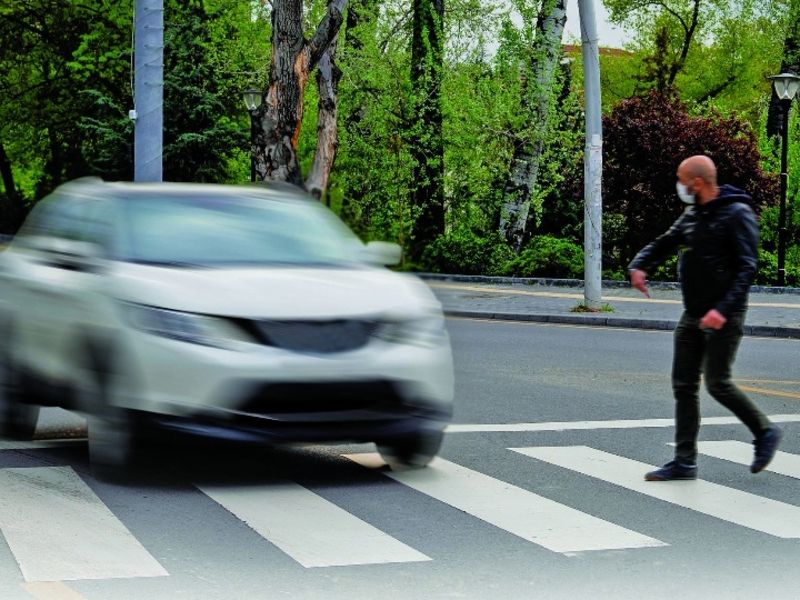
Despite a precipitous drop in travel, pedestrians are dying in increasing numbers across the United States.
Highway safety officials say speeding motorists and diminished traffic enforcement may be driving an increase in pedestrian fatalities that’s reached historic proportions during the pandemic. Approximately 6,721 died in 2020, according to estimates from the Governors Highway Safety Association.
If it holds, that would be the highest number of pedestrian fatalities in 31 years.
The number represents a 4.8 percent increase over 2019. Troubling on its own, the increase comes during a year when the number of vehicle miles traveled declined by 13.2 percent, according to the Federal Highway Administration.
Combined, the increase in deaths and lower travel rate result in a pedestrian fatality rate of 2.3 deaths per 1 billion miles traveled, a 21 percent year-over-year increase from the rate of 1.9 deaths in 2019.
“On one hand, it’s not surprising because we’ve been talking about this for a year now,” said Jonathan Adkins, executive director of the Governors Highway Safety Association. “But a year-plus after COVID hit, and now with a full year’s worth of data, it’s still really shocking that traffic deaths have skyrocketed like this. We never thought this would happen.”
Traffic deaths overall rose during the pandemic approximately 7.2 percent year over year, according to estimates released this month by NHTSA, reaching 38,680. That’s the highest number since 2007.
“We have a growing crisis, a public-health crisis, on our nation’s roadways,” National Transportation Safety Board member Jennifer Homendy said on a May episode of the Shift mobility podcast. “Normally during economic downtowns or crisis, you see improvements in road safety. We see the opposite. We see more speeding, crashes, more impaired driving, things we haven’t normally seen when [vehicle miles traveled] is down.”
Five of NTSB’s 10 “Most Wanted” safety improvements across the transportation spectrum address highways in some fashion, including one that calls for roadway improvements that better meet the needs of pedestrians, bicyclists and motorcyclists.
Pedestrian deaths, which were 16.1 percent of overall traffic deaths last year, according to NHTSA, were already rising before the pandemic. They had increased seven out of 10 years in the decade preceding the pandemic, according to Insurance Institute for Highway Safety statistics. In that time, they have gone from a modern-era low of 4,109 in 2009 to 6,205 in 2019.
One factor in the decade-long climb has been the surge in sales of SUVs and pickups. Because of higher front-end designs, collisions with pedestrians are more deadly, according to a 2020 IIHS report, and their proliferation has led to more lethal collisions.
A New York state senator introduced legislation this year that would require the state’s department of motor vehicles to create a pedestrian-safety rating system, akin to NHTSA’s five-star crash test ratings, that would be displayed on each vehicle and made available for consumers online.
While vehicle type has contributed to a steady increase in pedestrian fatalities, it does not explain the staggering rise in 2020. Adkins said motorists are driving faster at a time when law enforcement has reduced traffic stops.
“We’re seeing movements like ‘defund the police,’ and it’s having an impact on traffic safety enforcement,” he said. “Officers are less likely to want to make stops. We definitely need to look at equity, but we can’t just end traffic enforcement. We’re increasingly concerned there’s a movement afoot to end traffic enforcement when we don’t have solutions in place.”
Such solutions might one day include more widespread use of automated traffic enforcement cameras. A group of safety organizations including the governors association and IIHS issued a checklist last month that provides a road map for introducing photo enforcement, the use of which has been on the decline. Further fixes might include use of more effective driver-assistance systems, which are being rolled out in response to European vehicle-safety regulations.
Those might be long-term countermeasures. But Adkins emphasizes the pedestrian-death scourge remains acute. Early observations indicate deaths are not abating even as traditional travel habits return after the pandemic-related anomaly.
“I’ve been talking with chiefs of police and others, and anecdotally, it’s not going back down,” Adkins said.
“Traffic, things are getting back to normal, but the deaths are not going down. I’m afraid this will be one of the things that stays with us after COVID.”

